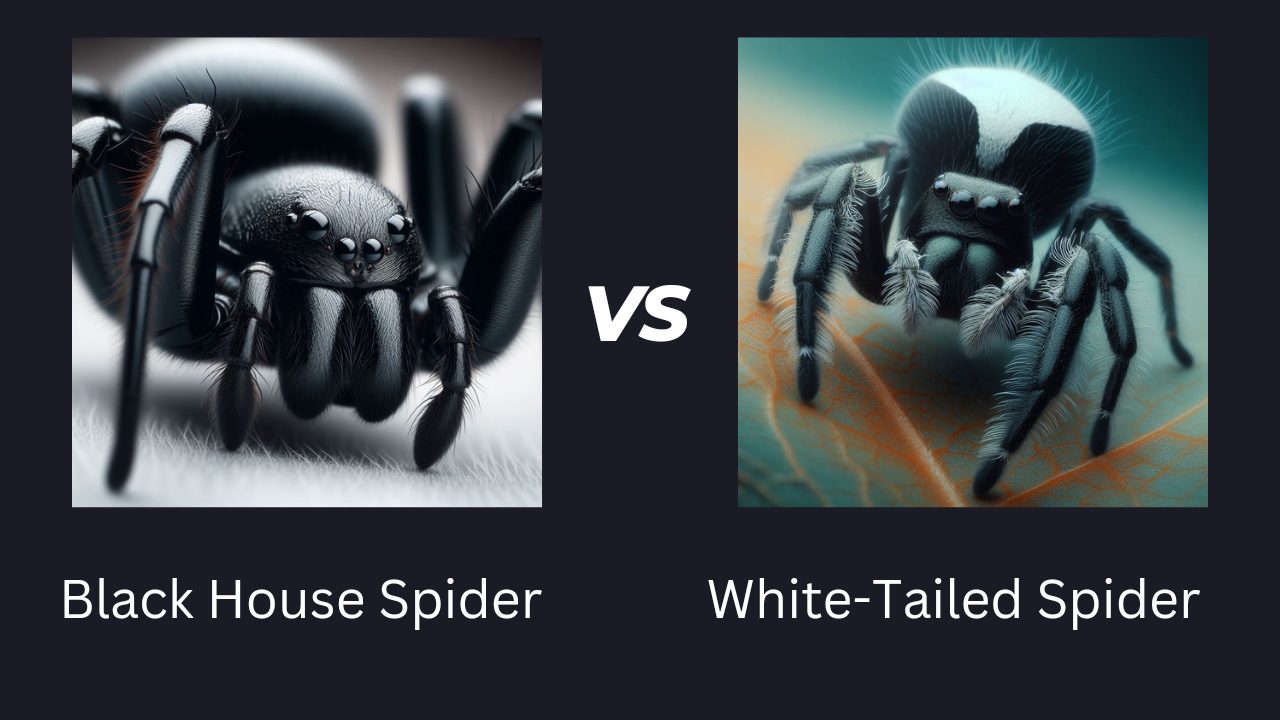Welcome to the interesting world of spiders, where the White-Tailed and Black House Species are the main attraction! These beauties of eight legs, each with unique attributes, are similar to superheroes found in nature. As we study the appearance, habitat, and activities of these spiders, picture solving a puzzle. It’s similar to entering an adventure with spiders! Come along on this fascinating voyage as we examine and learn the mysteries of the White-Tailed and Black House spiders.
Identification:
The Black House Spider:
Introducing Badumna insignis, the scientific name for the Black House Spider. Imagine a smooth, black, robust spider with a web resembling a magnificent funnel. This spider is frequently seen hanging out in houses and other buildings, doing its spider thing.
The White-Tailed Spider:
Presenting Lampona cylindrata, the White-Tailed Spider. Its name comes from its sleek appearance, cylindrical body, and white-tipped tail. These spiders are renowned for their swift movements and somewhat nomadic lifestyle.
Habitat:
Preferred Habitats of the Black House Spider:
Black House Spiders love cozy spots like corners, crevices, and undereaves. They’re the architects of intricate webs, and you’ll often spot them in quiet places inside homes.
Where to Find White-Tailed Spiders:
On the flip side, White-Tailed Spiders prefer the great outdoors. Think garden foliage, under bark, or hanging out in leaf litter. But don’t be surprised if you find them taking a detour into homes, seeking warmth in dark corners.
Behavior:
Black House Spider Behavior:
Black House Spiders are the chill types. They enjoy spending time inside their webs, waiting for their victim to approach. Their silk-lined hiding places act as both a strategic hunting area and a comfortable place to live.
White-Tailed Spider Behavior Compared:
Now, White-Tailed Spiders are the adventurers. They are fast hunters who are always searching for food. They could be investigating different areas indoors or outside when you run across them.
Health Effects:
Are Black House Spider Bites Harmful?:
Good news – Black House Spider bites are usually no big deal for humans. Just a bit of local pain and swelling, and serious reactions are super rare. These spiders aren’t the medical drama types.
Myths and Facts About White-Tailed Spider Venom:
Don’t let the myths fool you! Studies say White-Tailed Spider bites are unlikely to cause serious health issues. Most of the time, it’s just mild symptoms, putting those scary stories to rest.
Controlling Populations:
Natural Predators that Keep Numbers Low:
Both Black House Spiders and White-Tailed Spiders have their own set of enemies. Other spiders, birds, and insects keep their populations in check, creating a balanced spider world.
Non-Toxic Control Methods:
For folks wanting to keep spiders in check, non-toxic methods work like a charm. Seal those entry points and keep things clean – no need to harm the environment.
Reducing Encounters:
Tips for Excluding Spiders from Homes:
If you want fewer spider meet-ups indoors, it’s as simple as sealing cracks, keeping things tidy, and regular cleaning. Your living space will thank you for it!
Teaching Children Not to Fear Spiders:
Time for a spider talk with the kiddos! Share the scoop on how spiders help the world and clear up any myths. It’s all about understanding, not fearing our spider pals.
Importance in the Environment:
Role of Black House Spiders as Pest Predators:
Black House Spiders are the unsung heroes of pest control. They chow down on all sorts of bugs, helping keep the insect population in check around homes.
All Creatures Great and Small in the Ecosystem:
Let’s remember – every living thing, including spiders, plays a part in keeping our planet healthy. Biodiversity is like the VIP pass to a balanced ecosystem.
Debunking Myths:
Setting the Record Straight on Spider Myths:
Time to clear the air on spider myths. Spiders aren’t the villains some make them out to be. Let’s focus on the real, amazing facts about these beneficial creatures.
Science Overcomes Superstition:
When in doubt, turn to science! Let’s use evidence-based info to kick superstitions to the curb and see spiders for the cool critters they really are.
Educating the Public:
Promoting Acceptance Not Fear:
Spread the word – spiders are friends, not foes! Public education is key to helping people appreciate and accept spiders for their role in the natural world.
Correcting Misinformation Saves Spiders:
Let’s be myth-busters and correct spider misinformation. Knowledge is power, and it helps us coexist with spiders minus the unnecessary fear.
Conclusion:
White-Tailed and Black House Spiders both have roles to perform in the dance of nature. Through debunking myths, recognizing their distinctive characteristics, and promoting cohabitation via education, we establish environments in which people and spiders dwell with far less anxiety. Let’s remember that the advantages of having spider neighbors far exceed any spidey jitters as we negotiate our own home environments.
